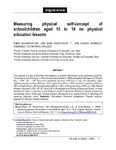Measuring Physical Self-Concept of Schoolchildren Aged 10 to 16 on Physical Education Lessons

Use this link to cite
http://hdl.handle.net/2183/25265
Except where otherwise noted, this item's license is described as Atribución-NoComercial-SinDerivadas 4.0 Internacional
Collections
- Investigación (FEDU) [939]
Metadata
Show full item recordTitle
Measuring Physical Self-Concept of Schoolchildren Aged 10 to 16 on Physical Education LessonsAuthor(s)
Date
2020Citation
Navarro-Patón, R., Pazos-Couto, J.M., Rodríguez-Fernández, J.E., & Arufe-Giraldez, V. (2020). Measuring physical self-concept of schoolchildren aged 10 to 16 on physical education lessons. Journal of Human Sport and Exercise, 15(1), 1-13. doi: https://doi.org/10.14198/jhse.2020.151.01
Abstract
[Abstract] This research aim was to determine what happens to physical self-concept during compulsory schooling. 1419 students from Primary (n = 619) and Secondary School (n = 800) participated: 640 boys and 779 girls; Mage = 12.81, SD = 1.93. There were statistically significant differences in age and educational stage, regarding physical condition (PhC) (p < .001), appearance (AP) (p < .001), perceived competence (PC) (p < .001), strength (St) (p < .001) and self-esteem (SE) (p < .001); In the gender factor in PhC (p = .005). Results showed a decrease in PhC, AP, PC, St and SE in the passage from Primary to Secondary School, as these variables are higher in boys than in girls. Based on results, it should be reflected on teaching practice and methodology used in these ages, because physical self-concept is an important factor for becoming and remaining physically active.
Keywords
Self-esteem
Perceived competence
Physical condition
Appearance
Physical education
Strength
Perceived competence
Physical condition
Appearance
Physical education
Strength
Editor version
Rights
Atribución-NoComercial-SinDerivadas 4.0 Internacional
ISSN
1988-5202






